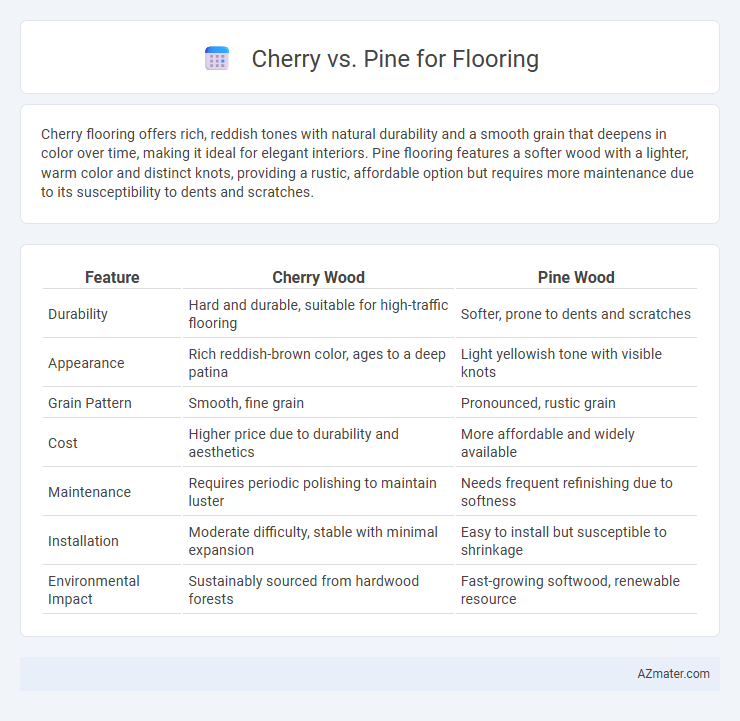Cherry flooring offers rich, reddish tones with natural durability and a smooth grain that deepens in color over time, making it ideal for elegant interiors. Pine flooring features a softer wood with a lighter, warm color and distinct knots, providing a rustic, affordable option but requires more maintenance due to its susceptibility to dents and scratches.
Table of Comparison
| Feature | Cherry Wood | Pine Wood |
|---|---|---|
| Durability | Hard and durable, suitable for high-traffic flooring | Softer, prone to dents and scratches |
| Appearance | Rich reddish-brown color, ages to a deep patina | Light yellowish tone with visible knots |
| Grain Pattern | Smooth, fine grain | Pronounced, rustic grain |
| Cost | Higher price due to durability and aesthetics | More affordable and widely available |
| Maintenance | Requires periodic polishing to maintain luster | Needs frequent refinishing due to softness |
| Installation | Moderate difficulty, stable with minimal expansion | Easy to install but susceptible to shrinkage |
| Environmental Impact | Sustainably sourced from hardwood forests | Fast-growing softwood, renewable resource |
Introduction: Cherry vs Pine Flooring
Cherry flooring offers rich, warm tones and a smooth grain pattern that deepens in color over time, making it a popular choice for luxurious interiors. Pine flooring provides a lighter, rustic appearance with visible knots and grain, creating a casual and cozy atmosphere. Both hardwoods vary in durability, with cherry being harder and more resistant to dents compared to the softer pine.
Wood Characteristics: Cherry and Pine
Cherry wood features a rich, reddish-brown hue that deepens with age, offering durability and resistance to wear ideal for high-traffic flooring. Pine wood, characterized by its lighter yellowish tones and prominent knots, provides a softer surface that is more prone to dents and scratches. Both woods exhibit distinct grain patterns, with cherry displaying a smoother, tighter grain compared to pine's more pronounced and rustic texture.
Appearance and Aesthetic Appeal
Cherry flooring offers a rich, warm reddish-brown hue that deepens over time, creating a luxurious and elegant aesthetic ideal for formal or traditional interiors. Pine flooring showcases a lighter, natural yellowish tone with prominent knots and grain patterns, delivering a rustic, casual charm suited for country or cottage-style spaces. The smooth, uniform texture of cherry contrasts with pine's more varied, textured grain, influencing the overall ambiance and style of the flooring choice.
Hardness and Durability Comparison
Cherry wood flooring rates around 2.5 on the Janka hardness scale, making it moderately hard but softer than many hardwoods. Pine floors, typically softer, average between 0.7 and 1.4 on the Janka scale depending on the species, making them more susceptible to dents and scratches. Cherry offers greater durability and better resistance to wear over time, while pine requires more maintenance to maintain its appearance in high-traffic areas.
Cost and Affordability
Cherry flooring typically costs between $8 to $14 per square foot, making it a more premium and expensive option due to its rich color and durability. Pine flooring is generally more affordable, ranging from $3 to $7 per square foot, appealing to budget-conscious homeowners seeking a rustic or vintage look. The choice between cherry and pine flooring involves weighing the higher upfront investment of cherry against pine's cost-effectiveness and softer texture.
Maintenance and Care Requirements
Cherry flooring demands moderate maintenance with regular dusting and occasional refinishing to preserve its rich, warm tones and smooth finish. Pine flooring requires more frequent care due to its softness and susceptibility to dents and scratches, including periodic sealing and gentle cleaning to protect its rustic character. Both woods benefit from controlled humidity levels and avoiding abrasive cleaners to extend their lifespan and maintain aesthetic appeal.
Installation Differences
Cherry flooring requires precise acclimation and careful handling during installation due to its hardwood density and fine grain, often necessitating professional expertise to avoid surface damage. Pine flooring, being softer and more pliable, allows for easier installation with common tools and is more forgiving of subfloor imperfections, making it a popular choice for DIY projects. Both materials demand proper moisture control, but pine's greater expansion rate requires attention to spacing during installation to prevent buckling.
Environmental Impact and Sustainability
Cherry flooring is prized for its rich color and durability but has a slower growth rate, leading to higher environmental impact due to longer harvest cycles and increased deforestation risks. Pine, sourced from faster-growing softwoods, offers a more sustainable option with quicker replenishment rates and lower carbon footprints, making it favorable for eco-conscious flooring choices. Both woods require responsible sourcing practices, such as FSC certification, to minimize environmental degradation and support sustainable forestry.
Best Applications for Each Wood Type
Cherry wood is ideal for formal interiors, luxurious furniture, and areas with moderate foot traffic due to its rich, warm tones and smooth grain, enhancing classic and elegant decor. Pine flooring suits rustic, country-style homes and casual spaces, providing a softer, lighter aesthetic that can handle wear in lower-traffic rooms or cabins. Each wood type offers distinct advantages: cherry excels in durability and sophistication for living rooms and dining areas, while pine is cost-effective and versatile for bedrooms, playrooms, and cottages.
Final Verdict: Choosing Between Cherry and Pine Flooring
Cherry flooring offers rich, warm hues and excellent durability, making it ideal for high-traffic areas and adding long-lasting elegance to any room. Pine flooring is softer and more affordable, with a rustic charm that suits casual or vintage interior styles but may dent and wear faster. Opt for cherry if you prioritize longevity and sophisticated aesthetics, while pine suits budget-conscious projects seeking a cozy, natural look.

Infographic: Cherry vs Pine for Flooring
 azmater.com
azmater.com